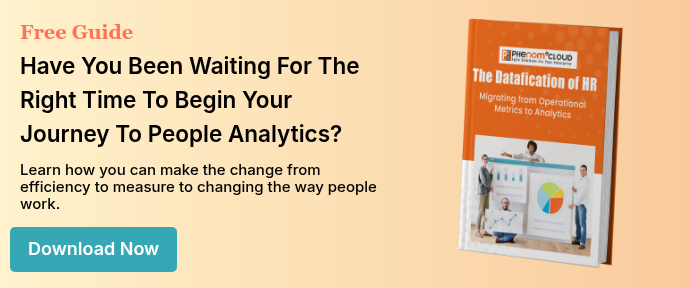
One of the primary roles of a CFO is to evaluate alternatives to achieve the maximum return on investment. CFOs use predictive and prescriptive analytics to achieve the optimum mix of investments in the business. This responsibility includes HR, but to most CFOs, people are an expense. They don’t understand how to measure the value of people and people programs.[1]
An Opportunity for Human Resources
We see this as an opportunity. CHROs can change the conversation by framing questions in terms of business results, using prescriptive analytics to optimize the outcome, and showing a return on investment. By partnering with the CFO on analytics, the CHRO can teach HR, the CFO can teach Finance, and the entire enterprise will benefit.
The Path to Predictive Analytics
We have been writing a lot about analytics recently, basing some of the discussion on the work of Jac Fitz-Enz and John R. Mattox, II. They describe three levels of human capital analytics (Figure 1):
1. Descriptive analytics examines historical data to evaluate connections, relationships, correlations, and causations.
2. Predictive analytics uses past patterns to predict future patterns.
3. Prescriptive analytics takes prediction to the next level by using complex data to predict alternative outcomes to optimize the workforce.[2]

We discussed descriptive and predictive analytics in previous articles. This article is about prescriptive human capital analytics and how it can transform your organization.
The Current State
Prescriptive analytics is the leading edge of business intelligence and has not yet gained widespread use. The evidence is in the search history in Google Trends (Figure 2).

While predictive analytics is rare in human capital, it is becoming commonplace in marketing. A few companies have gained global hegemonies with their analytics capabilities. You probably use it every day. Google predicts what you want to type in their search box. Amazon predicts what you want to buy next after you make a purchase.
Figure 3 gives us an idea of what each part of the analytics picture contributes to the information leaders need to make good decisions. Predictive analytics gives us a good idea of what the possibilities are, but prescriptive analytics adds the dimension of optimization by comparing outcomes.

When you are working with prescriptive analytics, we offer the same caution we did about predictive analytics. A false assumption will skew your results. Examine all your assumptions carefully and often. Make sure your analysts test your output for the validity of your assumptions. Ask about outliers and how they handled them.
The Future is Now
Almost all of the people we meet are still working from static reports or just beginning to make use of descriptive analytics. But now, analytical tools are more affordable, and the number of data analysts is growing. We expect exponential growth in the number of organizations using predictive and prescriptive analytics.
If you are still standing on the sidelines, we hope we can encourage you to get a start toward better analytics. We urge you to take advantage of this chance to give leaders the information they need to become human capital champions. The success of your enterprise may depend on it.
References :
[1] Phillips, Patricia Pulliam, PhD, and Jack J. Phillips, Phd. Making Human Capital Analytics Work: Measuring the ROI of Human Capital Processes and Outcomes. New York: McGraw-Hill, 2015.
[2] Fitz-Enz, Jac, and John R. Mattox, II. Predictive Analytics for Human Resources. New Jersey: Wiley Publishing, 2014.
PhenomᵉCloud is a full-service technology company dedicated to helping clients solve business problems, improve the capability of their people, and achieve better results.


Leave a Comment